
Adult California brown pelican in transition from non-breeding to breeding winter plumage. Note the brown hind neck of a breeding brown pelican is just filling in. This pelican already displays the red and olive throat and white and yellow head feathers of an adult winter brown pelican.
Species: Brown Pelican, Pelecanus occidentalis, Pelecanus occidentalis californicus
Location: La Jolla, California
Image ID: 38681
Species: Brown Pelican, Pelecanus occidentalis, Pelecanus occidentalis californicus
Location: La Jolla, California
Image ID: 38681
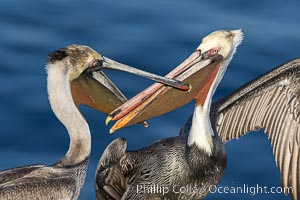
Brown pelicans jousting with their long bills, competing for space on a sea cliff over the ocean, with bright red throat, yellow and white head, adult non-breeding winter plumage.
Species: Brown Pelican, Pelecanus occidentalis, Pelecanus occidentalis californicus
Location: La Jolla, California
Image ID: 38684
Species: Brown Pelican, Pelecanus occidentalis, Pelecanus occidentalis californicus
Location: La Jolla, California
Image ID: 38684

Brown pelicans jousting with their long bills, competing for space on a sea cliff over the ocean, with bright red throat, yellow and white head, adult non-breeding winter plumage.
Species: Brown Pelican, Pelecanus occidentalis, Pelecanus occidentalis californicus
Location: La Jolla, California
Image ID: 38685
Species: Brown Pelican, Pelecanus occidentalis, Pelecanus occidentalis californicus
Location: La Jolla, California
Image ID: 38685

Brown pelicans jousting with their long bills, competing for space on a sea cliff over the ocean, with bright red throat, yellow and white head, adult non-breeding winter plumage.
Species: Brown Pelican, Pelecanus occidentalis, Pelecanus occidentalis californicus
Location: La Jolla, California
Image ID: 38703
Species: Brown Pelican, Pelecanus occidentalis, Pelecanus occidentalis californicus
Location: La Jolla, California
Image ID: 38703
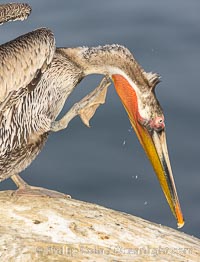
Pelican scratching neck and throat, note small bits of white feathers.
Species: Brown Pelican, Pelecanus occidentalis, Pelecanus occidentalis californicus
Location: La Jolla, California
Image ID: 38709
Species: Brown Pelican, Pelecanus occidentalis, Pelecanus occidentalis californicus
Location: La Jolla, California
Image ID: 38709

Brown pelicans jousting with their long bills, competing for space on a sea cliff over the ocean, with bright red throat, yellow and white head, adult non-breeding winter plumage.
Species: Brown Pelican, Pelecanus occidentalis, Pelecanus occidentalis californicus
Location: La Jolla, California
Image ID: 38833
Species: Brown Pelican, Pelecanus occidentalis, Pelecanus occidentalis californicus
Location: La Jolla, California
Image ID: 38833
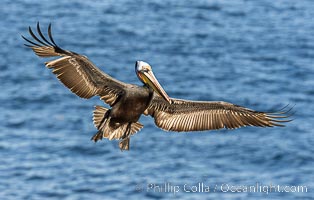
California brown pelican in flight, spreading wings wide to slow in anticipation of landing on seacliffs. Note the classic winter breeding plumage, with bright red throat, yellow and white head and neck, and brown hind neck.
Species: Brown, Pelecanus occidentalis, Pelecanus occidentalis californicus
Location: La Jolla, California
Image ID: 38963
Species: Brown, Pelecanus occidentalis, Pelecanus occidentalis californicus
Location: La Jolla, California
Image ID: 38963

California brown pelican adult winter breeding plumage portrait, showing brown hind neck nape, bright red gular pouch and yellow head, with white trim and yellow chevron on the chest.
Species: Brown, Pelecanus occidentalis, Pelecanus occidentalis californicus
Location: La Jolla, California
Image ID: 38965
Species: Brown, Pelecanus occidentalis, Pelecanus occidentalis californicus
Location: La Jolla, California
Image ID: 38965
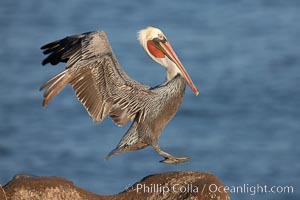
Brown pelican. This large seabird has a wingspan over 7 feet wide. The California race of the brown pelican holds endangered species status, due largely to predation in the early 1900s and to decades of poor reproduction caused by DDT poisoning. In winter months, breeding adults assume a dramatic plumage with brown neck, yellow and white head and bright red gular throat pouch.
Species: Brown Pelican, Pelecanus occidentalis, Pelecanus occidentalis californicus
Location: La Jolla, California
Image ID: 22158
Species: Brown Pelican, Pelecanus occidentalis, Pelecanus occidentalis californicus
Location: La Jolla, California
Image ID: 22158

Brown pelican. This large seabird has a wingspan over 7 feet wide. The California race of the brown pelican holds endangered species status, due largely to predation in the early 1900s and to decades of poor reproduction caused by DDT poisoning. In winter months, breeding adults assume a dramatic plumage with brown neck, yellow and white head and bright red gular throat pouch.
Species: Brown Pelican, Pelecanus occidentalis, Pelecanus occidentalis californicus
Location: La Jolla, California
Image ID: 22164
Species: Brown Pelican, Pelecanus occidentalis, Pelecanus occidentalis californicus
Location: La Jolla, California
Image ID: 22164

Brown pelican. This large seabird has a wingspan over 7 feet wide. The California race of the brown pelican holds endangered species status, due largely to predation in the early 1900s and to decades of poor reproduction caused by DDT poisoning. In winter months, breeding adults assume a dramatic plumage with brown neck, yellow and white head and bright red gular throat pouch.
Species: Brown Pelican, Pelecanus occidentalis, Pelecanus occidentalis californicus
Location: La Jolla, California
Image ID: 15128
Species: Brown Pelican, Pelecanus occidentalis, Pelecanus occidentalis californicus
Location: La Jolla, California
Image ID: 15128

White pelican.
Species: White pelican, Pelecanus erythrorhynchos
Location: San Elijo Lagoon, Encinitas, California
Image ID: 15719
Species: White pelican, Pelecanus erythrorhynchos
Location: San Elijo Lagoon, Encinitas, California
Image ID: 15719

Brown pelicans, breeding plumage (left) and non-breeding adult (right), sunrise. This large seabird has a wingspan over 7 feet wide. The California race of the brown pelican holds endangered species status, due largely to predation in the early 1900s and to decades of poor reproduction caused by DDT poisoning. In winter months, breeding adults assume a dramatic plumage with brown neck, yellow and white head and bright red gular throat pouch.
Species: Brown Pelican, Pelecanus occidentalis, Pelecanus occidentalis californicus
Location: La Jolla, California
Image ID: 18047
Species: Brown Pelican, Pelecanus occidentalis, Pelecanus occidentalis californicus
Location: La Jolla, California
Image ID: 18047

Brown pelican preening. After wiping its long beak on the uropygial gland near the base of its tail, the pelican spreads the preen oil on feathers about its body, helping to keep them water resistant, an important protection for a bird that spends much of its life diving in the ocean for prey. Adult winter non-breeding plumage showing white hindneck and red gular throat pouch.
Species: Brown Pelican, Pelecanus occidentalis, Pelecanus occidentalis californicus
Location: La Jolla, California
Image ID: 20033
Species: Brown Pelican, Pelecanus occidentalis, Pelecanus occidentalis californicus
Location: La Jolla, California
Image ID: 20033

A California brown pelican performs a head throw. During a bill throw, the pelican arches its neck back, lifting its large bill upward and stretching its throat pouch. Adult winter non-breeding plumage showing white hindneck and red gular throat pouch.
Species: Brown Pelican, Pelecanus occidentalis, Pelecanus occidentalis californicus
Location: La Jolla, California
Image ID: 20036
Species: Brown Pelican, Pelecanus occidentalis, Pelecanus occidentalis californicus
Location: La Jolla, California
Image ID: 20036

Brown pelican, non-breeding winter plumage. This large seabird has a wingspan over 7 feet wide. The California race of the brown pelican holds endangered species status, due largely to predation in the early 1900s and to decades of poor reproduction caused by DDT poisoning. Adult winter non-breeding plumage showing white hindneck and red gular throat pouch.
Species: Brown Pelican, Pelecanus occidentalis, Pelecanus occidentalis californicus
Location: La Jolla, California
Image ID: 20090
Species: Brown Pelican, Pelecanus occidentalis, Pelecanus occidentalis californicus
Location: La Jolla, California
Image ID: 20090

A brown pelican preening, reaching with its beak to the uropygial gland (preen gland) near the base of its tail. Preen oil from the uropygial gland is spread by the pelican's beak and back of its head to all other feathers on the pelican, helping to keep them water resistant and dry. Note adult winter breeding plumage in display, with brown neck, red gular throat pouch and yellow and white head.
Species: Brown Pelican, Pelecanus occidentalis, Pelecanus occidentalis californicus
Location: La Jolla, California
Image ID: 20262
Species: Brown Pelican, Pelecanus occidentalis, Pelecanus occidentalis californicus
Location: La Jolla, California
Image ID: 20262

Brown pelican portrait, displaying winter breeding plumage with distinctive dark brown nape, white and yellow yellow head feathers and red and yellow gular throat pouch.
Species: Brown Pelican, Pelecanus occidentalis, Pelecanus occidentalis californicus
Location: La Jolla, California
Image ID: 36842
Species: Brown Pelican, Pelecanus occidentalis, Pelecanus occidentalis californicus
Location: La Jolla, California
Image ID: 36842

Brown pelican. This large seabird has a wingspan over 7 feet wide. The California race of the brown pelican holds endangered species status, due largely to predation in the early 1900s and to decades of poor reproduction caused by DDT poisoning. In winter months, breeding adults assume a dramatic plumage with brown neck, yellow and white head and bright red gular throat pouch.
Species: Brown Pelican, Pelecanus occidentalis, Pelecanus occidentalis californicus
Location: La Jolla, California
Image ID: 22165
Species: Brown Pelican, Pelecanus occidentalis, Pelecanus occidentalis californicus
Location: La Jolla, California
Image ID: 22165

Brown pelican. This large seabird has a wingspan over 7 feet wide. The California race of the brown pelican holds endangered species status, due largely to predation in the early 1900s and to decades of poor reproduction caused by DDT poisoning. In winter months, breeding adults assume a dramatic plumage with brown neck, yellow and white head and bright red gular throat pouch.
Species: Brown Pelican, Pelecanus occidentalis, Pelecanus occidentalis californicus
Location: La Jolla, California
Image ID: 22175
Species: Brown Pelican, Pelecanus occidentalis, Pelecanus occidentalis californicus
Location: La Jolla, California
Image ID: 22175

A California brown pelican preening, reaching with its beak to the uropygial gland (preen gland) near the base of its tail. Preen oil from the uropygial gland is spread by the pelican's beak and back of its head to all other feathers on the pelican, helping to keep them water resistant and dry. Adult winter breeding plumage showing white hindneck and red gular throat pouch.
Species: Brown Pelican, Pelecanus occidentalis, Pelecanus occidentalis californicus
Location: La Jolla, California
Image ID: 37625
Species: Brown Pelican, Pelecanus occidentalis, Pelecanus occidentalis californicus
Location: La Jolla, California
Image ID: 37625

Utthita Marichyasana, extended sage pose, pelican yoga. A California brown pelican preening, reaching with its beak to the uropygial gland (preen gland) near the base of its tail. Preen oil from the uropygial gland is spread by the pelican's beak and back of its head to all other feathers on the pelican, helping to keep them water resistant and dry. Adult winter breeding plumage showing white hindneck and red gular throat pouch.
Species: Brown Pelican, Pelecanus occidentalis, Pelecanus occidentalis californicus
Location: La Jolla, California
Image ID: 37626
Species: Brown Pelican, Pelecanus occidentalis, Pelecanus occidentalis californicus
Location: La Jolla, California
Image ID: 37626

California brown pelican, showing characteristic winter plumage including red/olive throat, brown hindneck, yellow and white head colors.
Species: Brown pelican, Pelecanus occidentalis californicus
Location: La Jolla, California
Image ID: 26470
Species: Brown pelican, Pelecanus occidentalis californicus
Location: La Jolla, California
Image ID: 26470

California brown pelican, showing characteristic winter plumage including red/olive throat, brown hindneck, yellow and white head colors.
Species: Brown pelican, Pelecanus occidentalis californicus
Location: La Jolla, California
Image ID: 26471
Species: Brown pelican, Pelecanus occidentalis californicus
Location: La Jolla, California
Image ID: 26471

White pelican, breeding adult with fibrous plate on upper mandible of bill, Batiquitos Lagoon.
Species: White pelican, Pelecanus erythrorhynchos
Location: Batiquitos Lagoon, Carlsbad, California
Image ID: 15650
Species: White pelican, Pelecanus erythrorhynchos
Location: Batiquitos Lagoon, Carlsbad, California
Image ID: 15650

Brown pelican. This large seabird has a wingspan over 7 feet wide. The California race of the brown pelican holds endangered species status, due largely to predation in the early 1900s and to decades of poor reproduction caused by DDT poisoning. In winter months, breeding adults assume a dramatic plumage with brown neck, yellow and white head and bright red gular throat pouch.
Species: Brown Pelican, Pelecanus occidentalis, Pelecanus occidentalis californicus
Location: La Jolla, California
Image ID: 22145
Species: Brown Pelican, Pelecanus occidentalis, Pelecanus occidentalis californicus
Location: La Jolla, California
Image ID: 22145

White pelican on the Snake River.
Species: White pelican, Pelecanus erythrorhynchos
Location: Grand Teton National Park, Wyoming
Image ID: 13054
Species: White pelican, Pelecanus erythrorhynchos
Location: Grand Teton National Park, Wyoming
Image ID: 13054
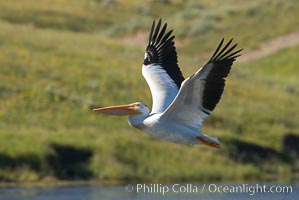
White pelican flies over the Yellowstone River.
Species: White pelican, Pelecanus erythrorhynchos
Location: Hayden Valley, Yellowstone National Park, Wyoming
Image ID: 13108
Species: White pelican, Pelecanus erythrorhynchos
Location: Hayden Valley, Yellowstone National Park, Wyoming
Image ID: 13108

White pelican on the Yellowstone River.
Species: White pelican, Pelecanus erythrorhynchos
Location: Hayden Valley, Yellowstone National Park, Wyoming
Image ID: 13110
Species: White pelican, Pelecanus erythrorhynchos
Location: Hayden Valley, Yellowstone National Park, Wyoming
Image ID: 13110

White pelican flies over the Yellowstone River.
Species: White pelican, Pelecanus erythrorhynchos
Location: Hayden Valley, Yellowstone National Park, Wyoming
Image ID: 13112
Species: White pelican, Pelecanus erythrorhynchos
Location: Hayden Valley, Yellowstone National Park, Wyoming
Image ID: 13112